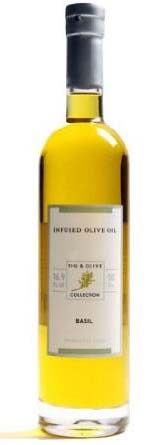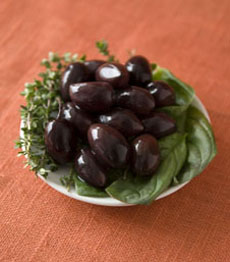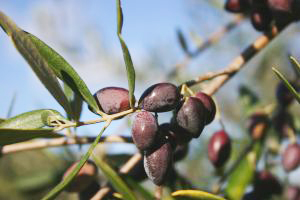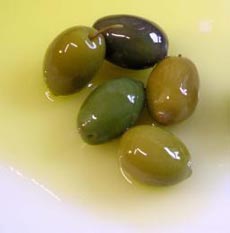Olive Oil & Olives Glossary
Page 5: Terms With H ~ K
This is Page 5 of the Olive Oil & Olives Glossary. If you think we should consider terms or definitions than those we have provided, use the Contact Us links on this page. Also read our article, Flavors and Aromas of Olive Oil. Visit our collection of 60+ food glossaries to learn more about other food products.
You can click on the letter of the alphabet in the bar below to get to a term
without having to scroll manually.
a b c d e f g h i j k l m n o p q r s t u v w x y z
This glossary is protected by copyright and cannot be reproduced in whole or part.
HAND-PICKED
Olives that are picked by hand instead of harvested with a shaker or a row type harvester. Hand picking is considered to produce a better olive oil than fruit that is mechanically harvested. Mechanical harvesting can bruise the fruit, increasing acidity, but others argue that mechanically harvested fruit can also get to the press quicker, which lowers acidity. Detractors say that this might be true in a scenario of mass-produced oil, but any artisan-produced oil will harvested in much smaller amounts by hand gotten to the press within hours, the best of both worlds. Olives harvested with a hand-held pneumatic rake are usually considered “hand picked.”
HARVESTING
Harvesting of the fruit is done in the autumn. Harvesting usually continues for about two months, or until the fruit becomes damaged by frost. The table olive harvest is done by hand-picking so as not to bruise the fruit; ladders are used to climb into the tree.
HEALTH CLAIMS
The FDA allows olive oil manufacturers to place a health claim on bottles linking olive oil to reduced risk of coronary heart disease. Olive oil controls LDL (“bad”) cholesterol levels while raising HDL (“good” cholesterol) levels. Continuing research indicates there may be other benefits as well, from the redistribution of body fat to painkilling properties, but these have not yet received FDA sanction.
HOJIBLANCA OLIVE
One of the major olive varieties of southern Spain, grown in the provinces of Córdoba, Granada, Malaga and Sevilla. Hojiblanca produces a yellow oil with a green and violet tinge. Its flavors vary between intense and fruity, and smooth and sweet. The oil is known for nuances of apple and green grass, which can give it a hint of bitterness, and almond finish. It is enjoyed for its smooth taste and lightness on the palate. Its stability is considered average.
 INFUSED OLIVE OIL INFUSED OLIVE OIL
Infusion is a method of flavor enhancement that adds the flavor of herbs or fruits into olive oil through crushing the produce along with the olives (or steeping the herbs/fruits in the oil and then removing them), or by adding the oil (or essence) of the produce to the olive oil. It different from “flavored” olive oils, which add less expensive, alcohol-based extracts (which can cost $7 per gallon, compared to $200 or $300 per gallon for essence). Check to see the base of the infused olive oil; the best ones will use extra virgin olive oil. See flavored olive oil. Notes:
(1) It is not safe to prepare homemade infused olive oils unless they will be used immediately. The inclusions (herbs, chiles, peppercorns, etc.) may promote bacterial growth that can cause illness. Commercial processes eliminate harmful bacterial growth.
(2) IOOC Definition: Technically, olive oil which has had herbs or fruits infused in it cannot be called olive oil. According to IOOC regulations it must be called “fruit juice.” In reality, few producers comply with this, labeling their products “lemon infused olive oil” or “basil olive oil.” Because of their immense popularity, the California Olive Oil Council is trying to come up with a meaningful labeling standard for flavored and infused oils.
Basil-infused olive oil from Fig & Olive Connection.
IOOC
The International Olive Oil Council (IOOC) determines standards for grades of olive oil  for most of the world. for most of the world.
KALAMATA or CALAMON OLIVE
A large, meaty black or deep purple olive, up to one inch in length, with a rich, fruity flavor. The almond-shaped Kalamata is largely used as a table olive, not generally pressed into oil. It is popularly served with lamb, swordfish and pasta dishes and is a component of a Greek salad. As a cocktail olive, it pairs well with Merlot. It is named after the city of Kalamata, Greece, in the southern Peloponnesian mountains.
Photo of Kalamata olives by Corey Lugg | THE NIBBLE.
These are from Sonoma Farm.
KORONEIKI OLIVE
A small olive from the area around Kalamata, Greece, which represents close to 60%  of the total Greek olive-growing area. Although difficult to cultivate, it has a high yield and produces olive oil of exceptional quality. The oil is very fruity, with an aroma of leaves and grass and a flavor with notes of green apple. It has some astringency, with hints of almond, fig and bark. Though very flavorful, it has low stability, i.e., has a short shelf life once the bottle is opened, so use it up quickly. of the total Greek olive-growing area. Although difficult to cultivate, it has a high yield and produces olive oil of exceptional quality. The oil is very fruity, with an aroma of leaves and grass and a flavor with notes of green apple. It has some astringency, with hints of almond, fig and bark. Though very flavorful, it has low stability, i.e., has a short shelf life once the bottle is opened, so use it up quickly.
Photo of koroneiki olive by Aristides Papadakis | SXC.
Continue To Next Page: Terms With L & M
Go To The Article Index Above
Lifestyle Direct, Inc. All rights reserved. Images are the copyright of their individual owners.

|





 INFUSED OLIVE OIL
INFUSED OLIVE OIL  for most of the world.
for most of the world.  of the total Greek olive-growing area. Although difficult to cultivate, it has a high yield and produces olive oil of exceptional quality. The oil is very fruity, with an aroma of leaves and grass and a flavor with notes of green apple. It has some astringency, with hints of almond, fig and bark. Though very flavorful, it has low stability, i.e., has a short shelf life once the bottle is opened, so use it up quickly.
of the total Greek olive-growing area. Although difficult to cultivate, it has a high yield and produces olive oil of exceptional quality. The oil is very fruity, with an aroma of leaves and grass and a flavor with notes of green apple. It has some astringency, with hints of almond, fig and bark. Though very flavorful, it has low stability, i.e., has a short shelf life once the bottle is opened, so use it up quickly.